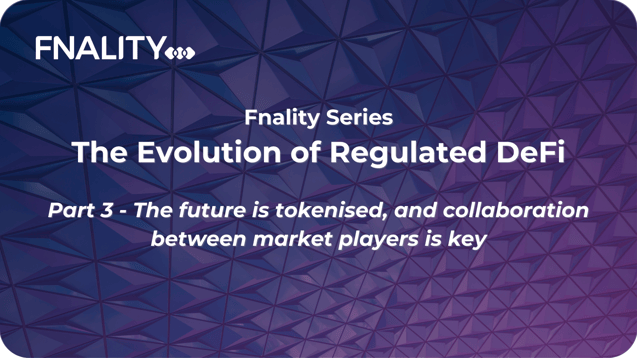
In our two previous blog posts on stablecoins and CBDCs, we have discussed why the speed of market acceptance of stablecoins has constituted a financial stability concern for oversight authorities, pushing them to speed up their discussion around building appropriate legal frameworks to regulate new payment solutions.
We have also explored the acceleration of CBDC discussions in response to the perceived threat to existing currencies that central bankers see in stablecoins.
In the third and final blog post of this series, we highlight that several traditional market players have demonstrated their intention to explore and enter the stablecoin/DeFi space as a competitive response.
The amount of retail and wholesale DLT initiatives launched to date are a strong indication that traditional institutions are now seeking to position themselves to develop and adopt tokenised financial market solutions.
In order to really empower tokenised financial markets, new means of payment, and new business cases, the most successful initiatives will eventually need to find a way to collaborate together to build a regulated, efficient and resilient financial ecosystem.
Traditional market players' initiatives in the stablecoin/ DeFi space
- JPM Coin: a digital token launched in 2019 to enable the instant settlement of transactions between the bank's wholesale payments business clients.
- Regulated Liability Network (RLN): Citi and SETL’s single network to record tokens and balances, where tokens represent the liability of a regulated entity. The RLN would be used to issue liabilities of commercial banks, e-money providers, as well as central banks (CBDC).
- Partior: a Singapore-based interbank payment system - founded by JPM, Temasek and DBS Bank - that provides a blockchain-based wholesale clearing and settlement platform, aiming to improve the speed, transparency, and cost of cross border payments.
- USDForward (USDF): a bank-backed stablecoin that will be built/minted on the Provenance blockchain exclusively by US banks, and will be redeemable on a 1:1 basis for cash from a consortium member bank. Founding bank members include New York Community Bank (NYCB), NBH Bank, FirstBank, Sterling National Bank, and Synovus Bank.
Latest retail DLT initiatives
- The launch of a digital currency test in 2022 by a consortium of Japanese firms (which sees all three of Fnality’s Japanese shareholders involved).
- A partnership between ConsenSys and Mastercard (ConsenSys Rollups) to create a CBDC test platform that enabled banks to simulate the issuance, distribution and exchange of CBDCs between banks and financial service providers. The platform aims to increase scale, efficiency, and speed of transactions both on the Ethereum Mainnet and permissioned blockchains.
- A partnership between ConsenSys and Visa to create a CBDC pilot program that aims to integrate DLT into existing retail payments applications, such as cards and wallets.
Wholesale DLT initiatives led by traditional market players
- State Street, Vanguard and Symbiont have completed their first live trade for FX forward contracts using DLT, aiming to address post-trade inefficiencies & reducing counterparty credit risk through automation.
- Wells Fargo and HSBC have announced the use of Baton Systems’ blockchain for the netting and settlement of matched foreign exchange (FX) transactions.
- Société Générale’s FORGE, together with Goldman Sachs and Santander, worked alongside the European Investment Bank (EIB) to issue a €100m 2-year digital bond on the Ethereum blockchain.
- Buy-side organisations are also moving quickly towards tokenisation. For example, in September 2021, BlackRock used Axoni for equity swap trading.
- BNYM, State Street, Citi and others have set up their own digital asset units. Nasdaq and Deutsche Boerse also have their own digital platforms.
How to unlock the potential of tokenised financial markets
Traditional market players' PoCs[1] have been demonstrated technical feasibility for some time. They indicate that tokenisation of financial markets is already well underway, and that it will eventually be regulated in a similar manner to the current state.
Tokenisation in and of itself doesn’t guarantee that the current issues present in financial market infrastructure will necessarily be solved:
- Even in the event that many of the traditional players’ initiatives reach success, the backing of assets will continue to be a liability of commercial banks[2], and so unsuitable for widespread wholesale adoption.
- All successful initiatives will require an ability to interoperate, and if this is in the form of a central Financial Market Infrastructure provider, the payment system will still be at risk of single point of failure or monopoly.
To truly unlock the potential of tokenised financial markets, these initiatives will need a decentralised interoperability layer - especially when it comes to cross-currency transactions - compatible with DLT platforms as well as centralised systems. Fnality can provide that interoperability.
But the convergence we foresee in the near future goes beyond tech design; it is about collaboration and the joining up of efforts to build a regulated, efficient and resilient financial ecosystem.
Fnality is open to collaboration!
[1] For an exhaustive list, please read here
[2] For a definition of Commercial bank money vs. Central bank money, please read Page 9 of the FED’s report
If you haven’t read the first two blog posts of this series, you can find our first blog post on the future of stablecoins here, and our second blog post on CBDC rollouts here.


